Document Outline
- FEATURES
- DESCRIPTION
- ORDERING INFORMATION
- QUICK REFERENCE DATA
- BLOCK DIAGRAM
- PINNING
- QUALITY AND RELIABILITY
- LIMITING VALUES
- CHARACTERISTICS
- FUNCTIONAL DESCRIPTION
- Introduction
- Microcontroller
- 80C51 features not supported by the SAA5290
- Additional features for the SAA5290
- Microcontroller interfacing
- TELETEXT DECODER FUNCTIONAL DESCRIPTION
- Data slicer
- Acquisition timing
- Teletext acquisition
- Page memory organization
- Extension packet memory organization
- Packet 26 processing
- Display
- Display timing
- Clock generator
- CHARACTER SETS
- APPLICATION INFORMATION
- PACKAGE OUTLINE
- SOLDERING
- DEFINITIONS
- LIFE SUPPORT APPLICATIONS
- PURCHASE OF PHILIPS I 2 C COMPONENTS

DATA SHEET
Preliminary specification
File under Integrated Circuits, IC02
February 1995
INTEGRATED CIRCUITS
Philips Semiconductors
SAA5290
One page Economy Teletext/TV
microcontroller

February 1995
2
Philips Semiconductors
Preliminary specification
One page Economy Teletext/TV
microcontroller
SAA5290
FEATURES
General
∑
Complete one page teletext decoder and TV
microcontroller in a single 52-pin package
∑
Eastern European, Western European and Turkish
language variants covered in one device
∑
Double size, double width and double height character
capability for On-Screen Display (OSD)
∑
Enhanced display features including meshing and
shadowing
∑
Separate display and acquisition timing for increased
flexibility
∑
Minimum peripheral component count
∑
525 line and 625 line display synchronization
∑
Standby mode through power-down of teletext and
analog hardware.
Microcontroller
∑
16 kbytes masked ROM (16 kbytes EEPROM variant for
product development)
∑
256 bytes of on-chip RAM
∑
Six 6-bit Pulse Width Modulators (PWM) and one 14-bit
precision PWM
∑
4-bit Digital-to-Analog Converter (DAC) and comparator
with a 3-input multiplexer allowing implementation of 3
Analog-to-Digital Converters (ADC) in software
∑
2 high current (10 mA) open-drain outputs
∑
Interrupt logic 0 triggered on rising and falling edges,
providing pulse-width measurement for remote control
decoding
∑
Master and slave bit-level I
2
C-bus hardware.
DESCRIPTION
The SAA5290 is a single-chip one page teletext decoder
and television control microcontroller. The device will
decode 625-line based World System Teletext
transmissions and provides television control functions
and On-Screen Display (OSD) functions.
The teletext decoder hardware is a derivative of the
SAA5254 (IVT1.1X), and the TV control functionality
provided by an on-chip industrial standard 80C51
microcontroller. A single-page static RAM is included
on-board providing a complete one page teletext decoder
and OSD memory.
The SAA5290 is available as a mask-programmed ROM
version. An EEPROM version is also available for product
development. Both versions are available in an SDIP52
package.
ORDERING INFORMATION
Notes
1. nnn is a three-digit number referencing the microcontroller program ROM mask.
2. I is a digit number referring to the language variant of the SAA5290ZP/NV.
TYPE NUMBER
MEMORY
PACKAGE
NAME
DESCRIPTION
VERSION
SAA5290ZP/nnn
(1)
ROM
SDIP52
plastic shrink dual in-line package; 52 leads (600 mil)
SOT247-1
SAA5290ZP/NVI
(2)
EEPROM
SDIP52
plastic shrink dual in-line package; 52 leads (600 mil)
SOT247-1
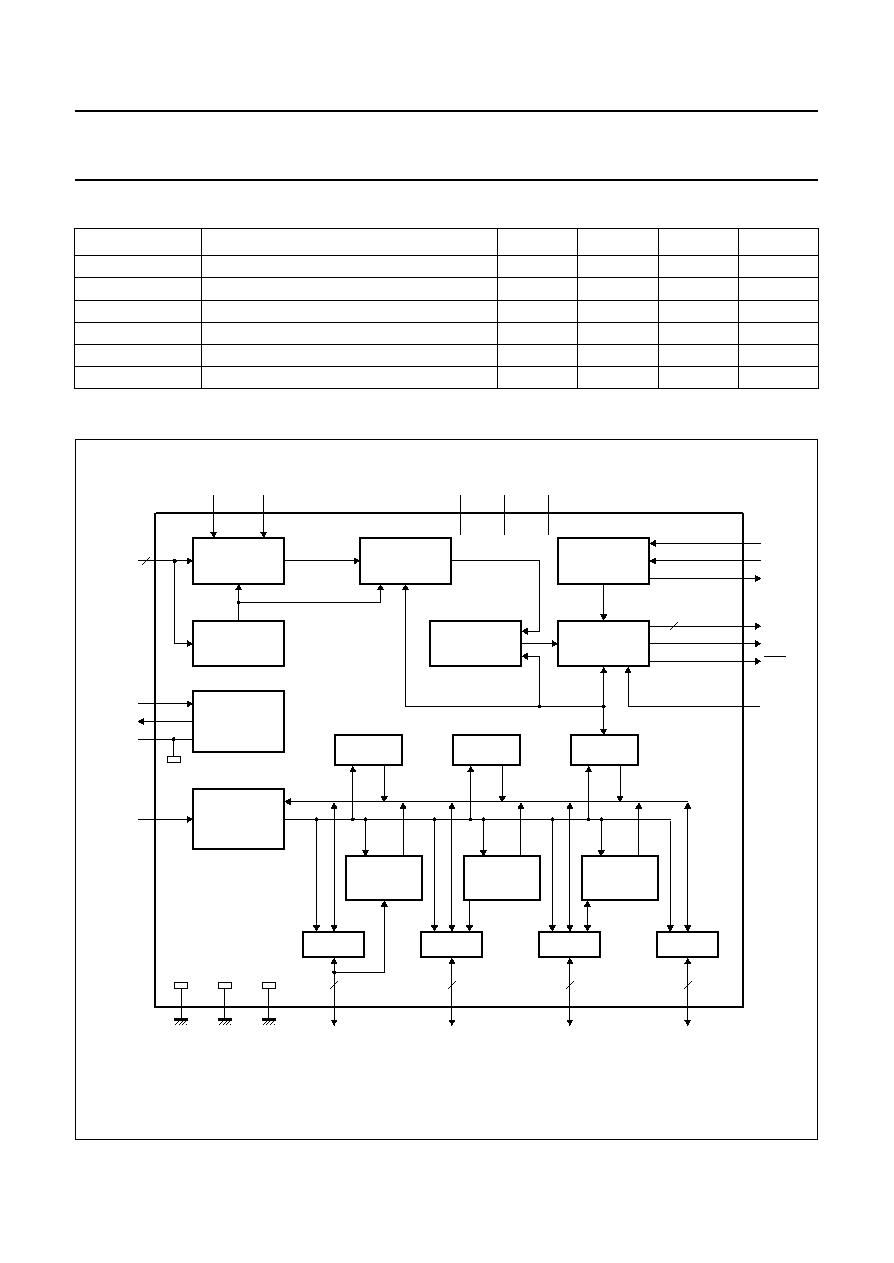
February 1995
3
Philips Semiconductors
Preliminary specification
One page Economy Teletext/TV
microcontroller
SAA5290
QUICK REFERENCE DATA
BLOCK DIAGRAM
SYMBOL
PARAMETER
MIN.
TYP.
MAX.
UNIT
V
DD
supply voltage
4.5
5.0
5.5
V
I
DDM
microcontroller supply current
-
25
40
mA
I
DDA
analog supply current
-
35
50
mA
I
DDT
teletext supply current
-
20
30
mA
f
xtal
crystal frequency
-
12
-
MHz
T
amb
operating ambient temperature
-
20
-
+70
∞
C
Fig.1 Block diagram.
handbook, full pagewidth
MLC102
DATA SLICER
ACQUISITION
TIMING
TELETEXT
ACQUISITION
DISPLAY
TIMING
DISPLAY
PAGE
RAM
OSCILLATOR
80C51
MICRO-
CONTROLLER
ANALOG-TO-
DIGITAL
CONVERTER
PULSE
WIDTH
MODULATOR
TIMER/
CTRS/ I C
2
data
address
16K x 8
ROM
PORT 3
9 to 12, 30
5
256 x 8
RAM
PORT 2
1 to 8
8
TEXT
INTERFACE
PORT 1
45 to 52
8
PORT 0
14 to 21
8
P3.0 to P3.4/
ADC0 to ADC2
P2.0 to P2.7
PWM
P1.0 to P1.7 / INT0,
INT1, T0, T1, SDA, SCL
P0.0 to P0.7
VSSA
22
VSSD2
VSSD1
28
13
43
RESET
40
OSCGND
42
OSCOUT
41
OSCIN
SAA5290
37
VSYNC
36
HSYNC
27
FRAME
RGBREF
34, 33, 32
R, G, B
35
31
VDS
29
COR
25
26
BLACK
IREF
CVBS0
CVBS1
23, 24
2
38
39
44
VDDM
VDDT
VDDA
3

February 1995
4
Philips Semiconductors
Preliminary specification
One page Economy Teletext/TV
microcontroller
SAA5290
PINNING
SYMBOL
PIN
DESCRIPTION
P2.0/TPWM
1
PORT 2: 8-bit open-drain bidirectional port with alternative functions. P2.0/TPWM is the
output for the 14-bit high precision PWM. P2.1/PWM0 to P2.6/PWM5 are the outputs for
the 6-bit PWMs 0 to 5.
P2.1/PWM0
2
P2.2/PWM1
3
P2.3/PWM2
4
P2.4/PWM3
5
P2.5/PWM4
6
P2.6/PWM5
7
P2.7
8
P3.0/ADC0
9
PORT 3: 5-bit open-drain bidirectional port with alternative functions. P3.0/ADC0 to
P3.2/ADC2 are the inputs for the software ADC facility.
P3.1/ADC1
10
P3.2/ADC2
11
P3.3
12
P3.4
30
V
SSD1
13
digital ground 1 for teletext and microcontroller circuits.
P0.0
14
PORT 0: 8-bit open-drain bidirectional port. P0.5 and P0.6 have 10 mA current sinking
capability at 0.5 V for direct drive of LEDs.
P0.1
15
P0.2
16
P0.3
17
P0.4
18
P0.5
19
P0.6
20
P0.7
21
V
SSA
22
analog ground.
CVBS0
23
Composite video input. A positive-going 1 V (peak-to-peak) input is required, connected
via a 100 nF capacitor.
CVBS1
24
BLACK
25
Video black level storage input. This pin should be connected to V
SSA
via a 100 nF
capacitor.
IREF
26
Reference current input for analog circuits, connected to V
SSA
via a 27 k
resistor.
FRAME
27
De-interlace output synchronized with the VSYNC pulse to produce a non-interlaced
display by adjustment of the vertical deflection currents.
V
SSD2
28
Digital ground 2.
COR
29
Open-drain, active LOW output which allows selective contrast reduction of the TV
picture to enhance a mixed mode display.
RGBREF
31
DC input voltage to define the output HIGH level on the RGB pins.
B
32
Dot rate character output of the BLUE colour information.
G
33
Dot rate character output of the GREEN colour information.
R
34
Dot rate character output of the RED colour information.
VDS
35
Video/data switch push-pull output for dot rate fast blanking.
HSYNC
36
Horizontal sync dedicated input for a TTL-level version of the horizontal sync pulse. The
polarity of this pulse is programmable by register bit TXT1.H POLARITY.

February 1995
5
Philips Semiconductors
Preliminary specification
One page Economy Teletext/TV
microcontroller
SAA5290
VSYNC
37
Vertical sync dedicated input for a TTL-level version of the vertical sync pulse. The
polarity of this pulse is programmable by register bit TXT1.V POLARITY.
V
DDA
38
+5 V analog power supply.
V
DDT
39
+5 V teletext power supply.
OSCGND
40
Crystal oscillator ground.
OSCIN
41
12 MHz crystal oscillator input.
OSCOUT
42
12 MHz crystal oscillator output.
RESET
43
If the reset input is HIGH for 2 machine cycles (24 oscillator periods) while the oscillator
is running, the SAA5290 is reset. This pin should be connected to V
DDM
via a 2.2
µ
F
capacitor.
V
DDM
44
+5 V microcontroller power supply.
P1.0/INT1
45
PORT 1: 8-bit open-drain bidirectional port with alternative functions. P1.0/INT1 is
external interrupt 1 which can be triggered on the rising and falling edge of the pulse.
P1.1/T0 is the counter/timer 0. P1.2/INT0 is external interrupt 0. P1.3/T1 is the
counter/timer 1. P1.6/SCL is the serial clock input for I
2
C-bus. P1.7/SDA is the serial
data port for the I
2
C-bus.
P1.1/T0
46
P1.2/INT0
47
P1.3/T1
48
P1.6/SCL
49
P1.7/SDA
50
P1.4
51
P1.5
52
SYMBOL
PIN
DESCRIPTION
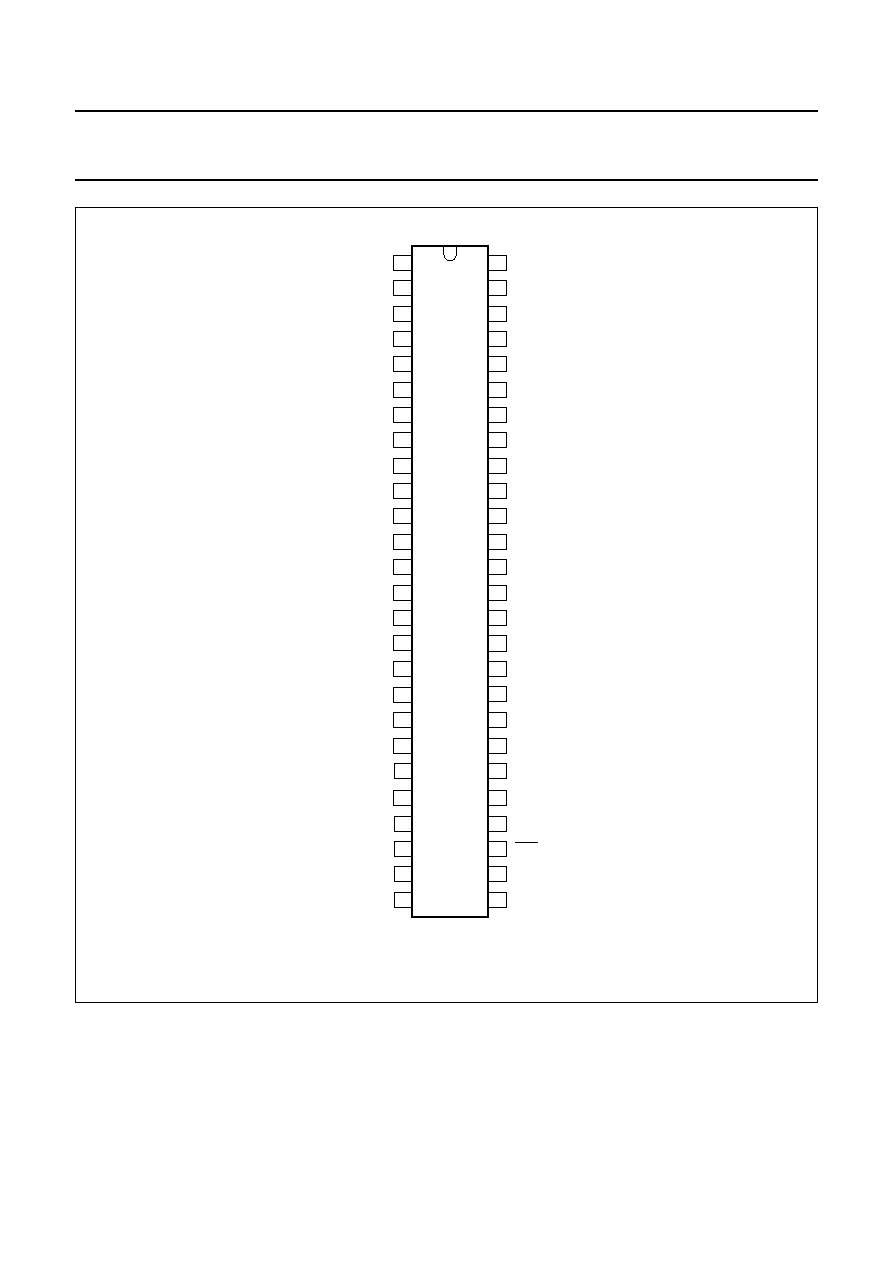
February 1995
6
Philips Semiconductors
Preliminary specification
One page Economy Teletext/TV
microcontroller
SAA5290
Fig.2 Pin configuration.
handbook, halfpage
1
2
3
4
5
6
7
8
9
10
11
12
13
40
39
38
37
36
35
34
33
32
31
30
29
28
27
14
15
16
17
18
19
20
22
23
24
25
26
21
42
41
43
44
45
46
47
48
49
50
51
52
MLC103
SAA5290
P2.0/TPWM
P2.1/PWM0
P2.2/PWM1
P2.3/PWM2
P2.4/PWM3
P2.5/PWM4
P2.6/PWM5
P2.7
P3.0/ADC0
P3.1/ADC1
P3.2/ADC2
P3.3
P0.0
P0.1
P0.2
P0.3
P0.4
P0.5
P0.6
P0.7
CVBS0
CVBS1
BLACK
IREF
SSD1
V
DDM
V
DDT
V
DDA
V
SSD2
V
SSA
V
P1.5
P1.4
P1.7/SDA
P1.6/SCL
P1.3/T1
P1.2/INT0
P1.1/T0
P1.0/INT1
RESET
OSCOUT
OSCIN
OSCGND
VSYNC
HSYNC
VDS
R
G
B
RGBREF
P3.4
COR
FRAME

February 1995
7
Philips Semiconductors
Preliminary specification
One page Economy Teletext/TV
microcontroller
SAA5290
QUALITY AND RELIABILITY
This device will meet Philips Semiconductors General Quality Specification for Business group
"Consumer Integrated
Circuits SNW-FQ-611-Part E" (see "Quality Reference Handbook", order number 9398 510 63011). The principal
requirements are shown in Tables 1 to 4.
Group A
Table 1 Acceptance tests per lot
Group B
Table 2 Processability tests (by package family)
Group C
Table 3 Reliability tests (by process family)
Table 4 Reliability tests (by device type)
Notes to Tables 1 to 4
1. ppm = fraction of defective devices, in parts per million.
LTPD = Lot Tolerance Percent Defective.
FPM = fraction of devices failing at test condition, in Failures Per Million.
FITS = Failures In Time Standard.
TEST
REQUIREMENTS
(1)
Mechanical
cumulative target:
<
80 ppm
Electrical
cumulative target:
<
80 ppm
TEST
REQUIREMENTS
(1)
Solderability
<
7% LTPD
Mechanical
<
15% LTPD
Solder heat resistance
<
15% LTPD
TEST
CONDITIONS
REQUIREMENTS
(1)
Operational life
168 hours at T
j
= 150
∞
C
<
1500 FPM; equivalent to
<
100 FITS at T
j
= 70
∞
C
Humidity life
temperature, humidity, bias
1000 hours, 85
∞
C, 85% RH
(or equivalent test)
<
2000 FPM
Temperature cycling performance
T
stg(min)
to T
stg(max)
<
2000 FPM
TEST
CONDITIONS
REQUIREMENTS
(1)
ESD and latch-up
ESD Human body model
2000 V, 100 pF, 1.5 k
<
15% LTPD
ESD Machine model
200 V, 200 pF, 0
<
15% LTPD
latch-up 100 mA, 1.5
◊
V
DD
(absolute maximum)
<
15% LTPD

February 1995
8
Philips Semiconductors
Preliminary specification
One page Economy Teletext/TV
microcontroller
SAA5290
LIMITING VALUES
In accordance with Absolute Maximum Rating System (IEC 134).
Notes
1. This maximum value has an absolute maximum of 6.5 V independent of V
DD
.
2. Except in standby mode.
CHARACTERISTICS
V
DD
= 5 V
±
10%; V
SS
= 0 V; T
amb
=
-
20 to +70
∞
C; unless otherwise specified.
SYMBOL
PARAMETER
CONDITIONS
MIN.
MAX.
UNIT
V
DD
supply voltage (all supplies)
-
0.3
+6.5
V
V
I
input voltage (any input)
note 1
-
0.3
V
DD
+ 0.5 V
V
O
output voltage (any output)
note 1
-
0.3
V
DD
+ 0.5 V
I
O
output current (each output)
-
±
10
mA
I
IOK
DC input or output diode current
-
±
20
mA
V
SS
difference between V
SSD
, V
SSA
and OSCGND
-
±
0.1
V
V
DD
difference between V
DDM
, V
DDT
and V
DDA
note 2
-
±
0.1
V
T
amb
operating ambient temperature
-
20
+70
∞
C
T
stg
storage temperature
-
55
+125
∞
C
SYMBOL
PARAMETER
CONDITIONS
MIN.
TYP.
MAX.
UNIT
Supplies
V
DD
supply voltage (V
DD
to V
SS
)
4.5
5.0
5.5
V
I
DDM
microcontroller supply current
-
25
40
mA
I
DDA
analog supply current
-
35
50
mA
I
DDT
teletext supply current
-
20
30
mA
Digital inputs
RESET
V
IL
LOW level input voltage
-
0.3
-
0.2V
DD
-
0.1 V
V
IH
HIGH level input voltage
0.7V
DD
-
V
DD
+ 0.3
V
I
LI
input leakage current
V
I
= 0 to V
DD
-
10
-
+10
µ
A
C
I
input capacitance
-
-
4
pF
HSYNC
AND
VSYNC
V
thf
switching threshold falling
0.2V
DD
-
-
V
V
thr
switching threshold rising
-
-
0.8V
DD
V
V
HYS
hysteresis voltage
-
0.33V
DD
-
V
C
I
input capacitance
-
-
4
pF

February 1995
9
Philips Semiconductors
Preliminary specification
One page Economy Teletext/TV
microcontroller
SAA5290
Digital outputs
R, G
AND
B (note 1)
V
OL
LOW level output voltage
I
OL
= 2 mA
0
-
0.2
V
V
OH
HIGH level output voltage
I
OH
=
-
2 mA
V
RGBREF
-
0.3
V
RGBREF
V
RGBREF
+ 0.4
V
|
Z
O
|
output impedance
-
-
150
C
L
load capacitance
-
-
50
pF
I
O
DC output current
-
-
-
4
mA
t
r
output rise time
between 10% and 90%;
C
L
= 50 pF
-
-
20
ns
t
f
output fall time
between 90% and 10%;
C
L
= 50 pF
-
-
20
ns
COR (
OPEN
-
DRAIN OUTPUT
)
V
OH
HIGH level pull-up output
voltage
-
-
V
DD
V
V
OL
LOW level output voltage
I
OL
= 2 mA
0
-
0.5
V
I
OL
LOW level output current
-
-
2
mA
C
L
load capacitance
-
-
25
pF
VDS
V
OL
LOW level output voltage
I
OL
= 1.6 mA
0
-
0.2
V
V
OH
HIGH level output voltage
I
OH
=
-
1.6 mA
V
DD
-
0.3
-
V
DD
+ 0.4
V
C
L
load capacitance
-
-
50
pF
t
r
output rise time
between 10% and 90%;
C
L
= 50 pF
-
-
20
ns
t
f
output fall time
between 90% and 10%;
C
L
= 50 pF
-
-
20
ns
R, G, B
AND
VDS
t
skew
skew delay between any two
pins
-
-
20
ns
FRAME
V
OH
HIGH level output voltage
I
OL
= 8 mA
0
-
0.5
V
V
OL
LOW level output voltage
I
OL
=
-
8 mA
V
DD
-
0.5
-
V
DD
V
I
OL
LOW level output current
-
8
-
+8
mA
C
L
load capacitance
-
-
100
pF
SYMBOL
PARAMETER
CONDITIONS
MIN.
TYP.
MAX.
UNIT
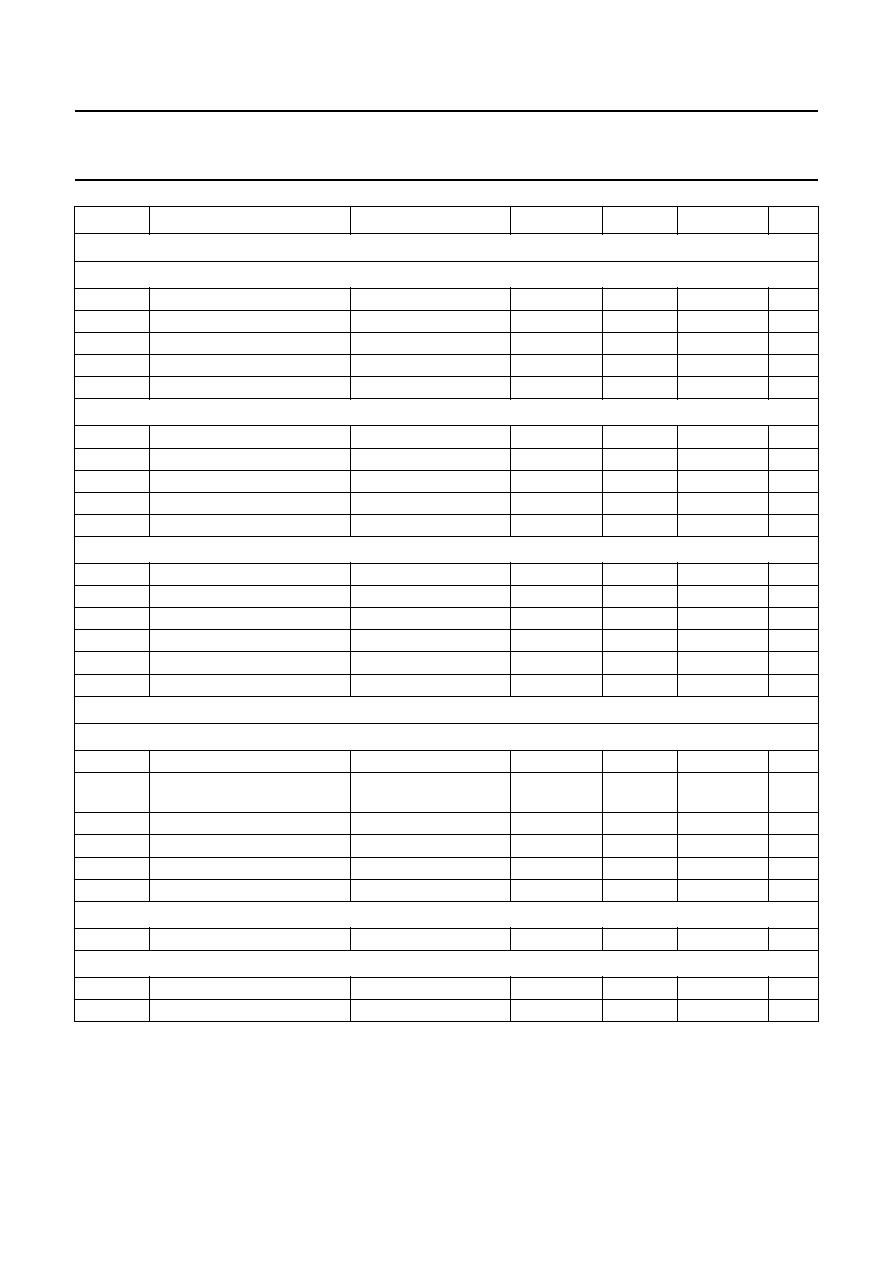
February 1995
10
Philips Semiconductors
Preliminary specification
One page Economy Teletext/TV
microcontroller
SAA5290
Digital input/outputs
P0.0
TO
P0.4, P0.7, P1.0
TO
P1.5, P2.0
TO
P2.7
AND
P3.0
TO
P3.5
V
IL
LOW level input voltage
-
0.3
-
0.2V
DD
-
0.1 V
V
IH
HIGH level input voltage
0.2V
DD
+ 0.9
-
V
DD
+ 0.3
V
C
I
input capacitance
-
-
4
pF
V
OL
LOW level output voltage
I
OL
= 3.2 mA
0
-
0.45
V
C
L
load capacitance
-
-
50
pF
P0.5
AND
P0.6
V
IL
LOW level input voltage
-
0.3
-
0.2V
DD
-
0.1 V
V
IH
HIGH level input voltage
0.2V
DD
+ 0.9
-
V
DD
+ 0.3
V
C
I
input capacitance
-
-
4
pF
V
OL
LOW level output voltage
I
OL
= 10 mA
0
-
0.45
V
C
L
load capacitance
-
-
50
pF
P1.6
AND
P1.7
V
IL
LOW level input voltage
-
0.3
-
+1.5
V
V
IH
HIGH level input voltage
3.0
-
V
DD
+ 0.3
V
C
I
input capacitance
-
-
5
pF
V
OL
LOW level output voltage
I
OL
= 3 mA
0
-
0.5
V
C
L
load capacitance
-
-
400
pF
t
f
output fall time
between 3 and 1 V
-
-
200
ns
Analog inputs
CVBS0
AND
CVBS1
V
sync
sync voltage amplitude
0.1
0.3
0.6
V
V
vid(p-p)
video input voltage amplitude
(peak-to-peak value)
0.7
1.0
1.4
V
Z
source
source impedance
-
-
250
V
IH
HIGH level input voltage
3.0
-
V
DD
+ 0.3
V
|
Z
I
|
input impedance
2.5
5.0
-
k
C
I
input capacitance
-
-
10
pF
IREF
R
gnd
resistor to ground
-
27
-
k
RGBREF (note 1)
V
I
input voltage
-
0.3
-
V
DD
V
I
I
DC input current
-
-
12
mA
SYMBOL
PARAMETER
CONDITIONS
MIN.
TYP.
MAX.
UNIT

February 1995
11
Philips Semiconductors
Preliminary specification
One page Economy Teletext/TV
microcontroller
SAA5290
Notes
1. All RGB current is sourced from the RGBREF pin. The maximum effective series resistance between RGBREF and
the R, G and B pins is 150
.
2. Crystal order number 4322 143 05561.
ADC0, ADC1
AND
ADC2
V
IL
LOW level input voltage
-
0.3
-
V
DD
V
Analog input/output
BLACK
C
black
storage capacitor to ground
-
100
-
nF
V
black
black level voltage for nominal
sync amplitude
1.8
2.15
2.5
V
I
LI
input leakage current
-
10
-
+10
µ
A
Crystal oscillator
OSCIN
V
IL
LOW level input voltage
-
0.3
-
0.2V
DD
-
0.1 V
V
IH
HIGH level input voltage
0.7V
DD
-
V
DD
+ 0.3
V
C
I
input capacitance
-
-
10
pF
OSCOUT
f
osc
crystal oscillator frequency
-
12
-
MHz
C
O
output capacitance
-
-
10
pF
C
RYSTAL SPECIFICATION
(note 2)
f
xtal
nominal frequency
-
12
-
MHz
C
L
load capacitance
-
32
-
pF
C1
series capacitance
T
amb
= 25
∞
C
-
18.5
-
fF
C0
parallel capacitance
T
amb
= 25
∞
C
-
4.9
-
pF
R
r
resonance resistance
T
amb
= 25
∞
C
-
35
-
T
xtal
temperature range
-
20
+25
+70
∞
C
X
j
adjustment tolerance
T
amb
= 25
∞
C
-
-
±
50
◊
10
-
6
X
d
drift
-
-
±
30
◊
10
-
6
SYMBOL
PARAMETER
CONDITIONS
MIN.
TYP.
MAX.
UNIT
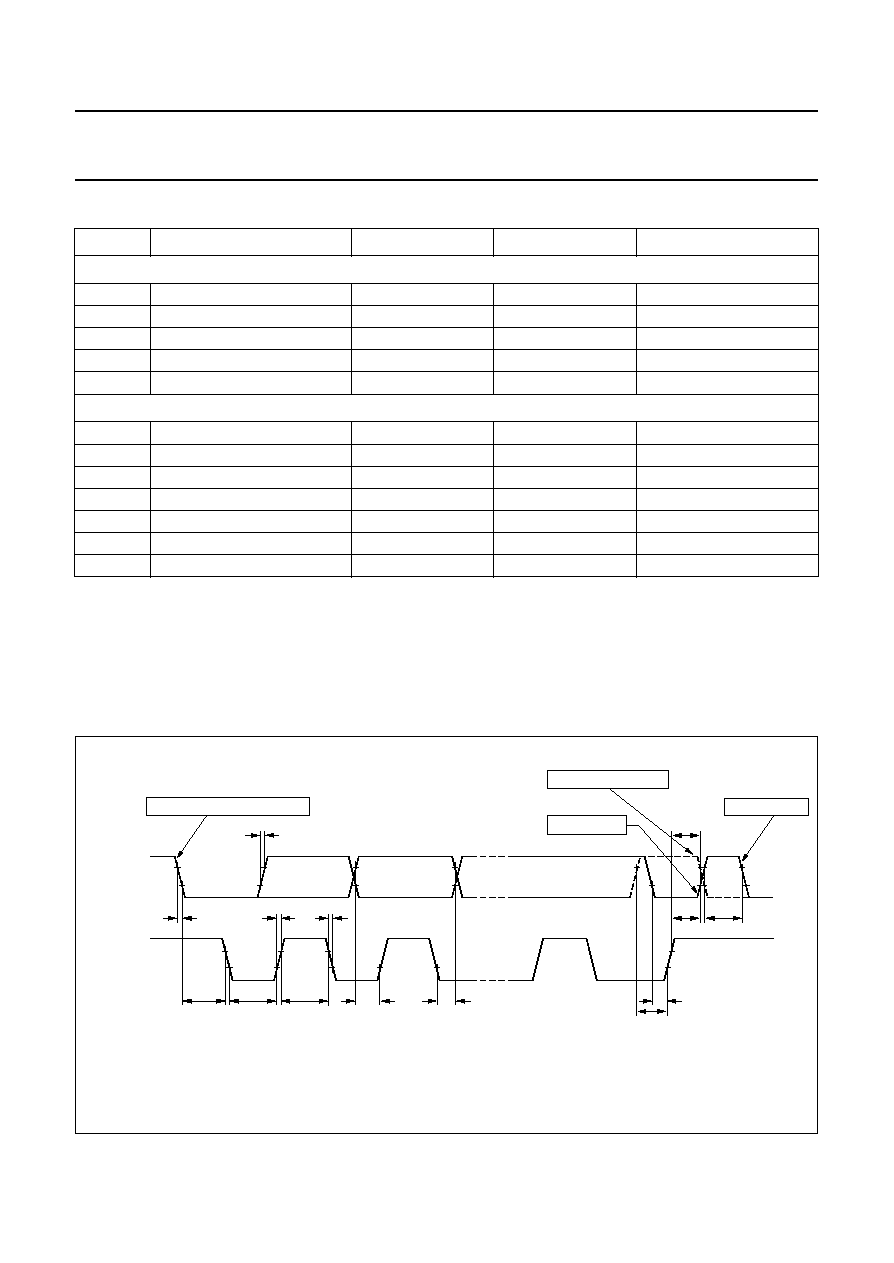
February 1995
12
Philips Semiconductors
Preliminary specification
One page Economy Teletext/TV
microcontroller
SAA5290
Table 5 Characteristics for the I
2
C-bus interface
Notes
1. This parameter is determined by the user software. It must comply with the I
2
C-bus specification.
2. This value gives the auto-clock pulse length which meets the I
2
C-bus specification for the special crystal frequency.
Alternatively, the SCL pulse must be timed by software.
3. The rise time is determined by the external bus line capacitance and pull-up resistor. It must be less than 1
µ
s.
4. The maximum capacitance on bus lines SDA and SCL is 400 pF.
SYMBOL
PARAMETER
INPUT
OUTPUT
I
2
C-BUS SPECIFICATION
SCL timing
t
HD;STA
START condition hold time
4.0
µ
s
note 1
4.0
µ
s
t
LOW
SCL LOW time
4.7
µ
s
note 1
4.7
µ
s
t
HIGH
SCL HIGH time
4.0
µ
s
4.0
µ
s; note 2
4.0
µ
s
t
rC
SCL rise time
1.0
µ
s
note 3
1.0
µ
s
t
fC
SCL fall time
0.3
µ
s
0.3
µ
s; note 4
0.3
µ
s
SDA timing
t
SU;DAT1
data set-up time
250 ns
note 1
250 ns
t
HD;DAT
data hold time
0 ns
note 1
0 ns
t
SU;STA
repeated START set-up time
4.7
µ
s
note 1
4.7
µ
s
t
SU;STO
STOP condition set-up time
4.0
µ
s
note 1
4.0
µ
s
t
BUF
bus free time
4.7
µ
s
note 1
4.7
µ
s
t
rD
SDA rise time
1.0
µ
s
note 3
1.0
µ
s
t
fD
SDA fall time
0.3
µ
s
0.3
µ
s; note 4
0.3
µ
s
d
th
t rD
t fD
t rC
t fC
t HD;STA
t LOW
t HIGH
t SU;DAT1
t HD;DAT
t SU;DAT2
t SU;DAT3
0.7VDD
0.3VDD
t SU;STO
t BUF
tSU;STA
SDA
(input / output)
SCL
(input / output)
START condition
repeated START condition
STOP condition
START or repeated START condition
0.7V DD
0.3VDD
MLC104
Fig.3 I
2
C-bus interface timing.

February 1995
13
Philips Semiconductors
Preliminary specification
One page Economy Teletext/TV
microcontroller
SAA5290
FUNCTIONAL DESCRIPTION
Introduction
The SAA5290 is an integrated teletext decoder and
microcontroller. The teletext decoder is derived from the
SAA5254 single page teletext decoder IC, with a number
of enhancements to increase its suitability for on-screen
display applications. The microcontroller is a derivative of
the industry standard 80C51 microcontroller. A block
diagram of the SAA5290 is given in Fig.1.
Microcontroller
The functionality of the microcontroller used on the
SAA5290 is described here with reference to the industry
standard 80C51 microcontroller. A full description of its
functionality can be found in the handbook
80C51-based
8-bit microcontrollers IC20. Using the 80C51 as a
reference, the changes made for the SAA5290 fall into two
categories, features not supported by the SAA5290 and
features found on the SAA5290 but not supported by the
80C51.
80C51 features not supported by the SAA5290
I
NTERRUPT PRIORITY
The IP SFR is not implemented and all interrupts are
treated with the same priority level. The SAA5290 retains
the normal prioritization of interrupts within a level.
Table 6 Interrupts and their vector addresses
EVENT
PROGRAM MEMORY ADDRESS
Reset
000H
External INT0
003H
Timer 0
00BH
External INT1
013H
Timer 1
01BH
I
2
C-bus
053H
O
FF
-
CHIP MEMORY
The SAA5290 does not support the use of off-chip
program memory or off-chip data memory. This means
that the SAA5290 does not have any of EA, RD, WR, ALE
or PSEN pins. The 4 MOVX instructions which move data
to and from external RAM should not be used.
I
DLE AND POWER
-
DOWN MODES
Idle and power-down modes are not supported by the
SAA5290. As a consequence, the respective bits in PCON
are not available.
UART
FUNCTION
The 80C51 UART is not available in the SAA5290. As a
consequence the SCON and SBUF SFRs are removed
and the ES bit in the IE SFR is unavailable.
Additional features for the SAA5290
The following features are provided by the SAA5290 in
addition to the standard 80C51 features.
I
NTERRUPTS
The external INT1 interrupt is modified to generate an
interrupt on both the rising and falling edges of the INT1
pin, when EX1 bit is set. This facility allows for software
pulse width measurement for handling of a remote control.
B
IT LEVEL
I
2
C-
BUS INTERFACE
The bit-level serial I/O supports the I
2
C-bus. P1.6/SCL and
P1.7/SDA are the serial I/O pins. These two pins meet the
I
2
C-bus specification concerning the input levels and
output drive capability. Consequently, these pins have an
open-drain output configuration. All the four following
modes of the I
2
C-bus are supported.
∑
Master transmitter
∑
Master receiver
∑
Slave transmitter

February 1995
14
Philips Semiconductors
Preliminary specification
One page Economy Teletext/TV
microcontroller
SAA5290
∑
Slave receiver.
The advantages of the bit-level I
2
C-bus hardware,
compared with a full software I
2
C-bus implementation are:
∑
The hardware can generate the SCL pulse
∑
Testing a single bit (RBF or WBF respectively) is
sufficient as a check for error-free transmission.
The bit-level I
2
C-bus hardware operates on serial bit level
and performs the following functions:
∑
Filtering the incoming serial data and clock signals
∑
Recognizing the START condition
∑
Generating a serial interrupt request SI after reception of
a START condition and the first falling edge of the serial
clock
∑
Recognizing the STOP condition
∑
Recognizing a serial clock pulse on the SCL line
∑
Latching a serial bit on the SDA line (SDI)
∑
Stretching the SCL LOW period of the serial clock to
suspend the transfer of the next serial data bit
∑
Setting Read Bit Finished (RBF) when the SCL clock
pulse has finished and Write Bit Finished (WBF) if there
is no arbitration loss detected (i.e. SDA = logic 0 while
SDO = logic 1)
∑
Setting a serial clock LOW-to-HIGH detected (CLH) flag
∑
Setting a Bus Busy (BB) flag on a START condition and
clearing this flag on a STOP condition
∑
Releasing the SCL line and clearing the CLH, RBF and
WBF flags to resume transfer to the next serial data bit
∑
Generating an automatic clock if the single bit data
register S1BIT is used in master mode.
The following functions must be done in software:
∑
Handling the I
2
C-bus START interrupts
∑
Converting serial data to parallel data when receiving
∑
Converting parallel data to serial data when transmitting
∑
Comparing the received slave address with its own
address
∑
Interpreting the acknowledge information
∑
Guarding the I
2
C-bus status if RBF or WBF = logic 0.
Additionally, if acting as master:
∑
Generating START and STOP conditions
∑
Handling bus arbitration
∑
Generating serial clock pulses if S1BIT is not used.
Three SFRs support the function of the bit-level I
2
C-bus
hardware, they are S1INT, S1BIT and S1SCS.
LED
SUPPORT
Port pins P0.5 and P0.6 have a 10 mA current sinking
capability to enable LEDs to be driven directly.
PWM DAC
S
The SAA5290 has six 6-bit PWM DACs and one14-bit
PWM DAC. These allow direct control of other parts of the
television.
The low resolution 6 bit DACs are controlled by their
corresponding SFR (PWM0 to PWM5) and are connected
as alternative outputs of Port P2. The port bit
corresponding to the PWM should be set to logic 1 for
correct operation of the PWM.
Table 7 Special Function Registers PWM0 to PWM5
If the PWE bit for a particular port is set to logic 1, the PWM
is active and controls its assigned port pin. If the PWE bit
is set to logic 0 the corresponding port pin is controlled by
the bit in the corresponding port register for that port.
The output of the PWM is a pulse of period 21.33
µ
s with
a duty cycle determined by the binary value, PV5 to PV0,
multiplied by 0.33
µ
s. The 14 bit PWM is controlled with
SFR registers TDACL and TDACH.
Table 8 Special Function Register TDACL
Table 9 Special Function Register TDACH
If the PWE bit is set to logic 1, the TPWM is active and
controls Port P2.0. If the PWE bit is set to logic 0 the port
pin is controlled by the bit in the corresponding port
register for P2.0.
The output of the TPWM is a pulse of period 42.66
µ
s with
a duty cycle determined by the binary value, TD13 to TD7,
multiplied by 0.33
µ
s.
D7
D6
D5
D4
D3
D2
D1
D0
PWE
-
PV5
PV4
PV3
PV2
PV1
PV0
D7
D6
D5
D4
D3
D2
D1
D0
TD7
TD6
TD5
TD4
TD3
TD2
TD1
TD0
D7
D6
D5
D4
D3
D2
D1
D0
PWE
-
TD13 TD12 TD11 TD10 TD9
TD8

February 1995
15
Philips Semiconductors
Preliminary specification
One page Economy Teletext/TV
microcontroller
SAA5290
The 7 least significant bits, TD6 to TD0, extend the HIGH
time of a proportion of the pulses by 0.33
µ
s. If the LSB is
set then 1 in 128 cycles is extended, if bit 1 is set then
1 in 64 cycles is extended, and so on.
S
OFTWARE
ADC
Up to 3 successive approximation ADCs can be
implemented in software by making use of the on-board
4-bit DAC and multiplexed voltage comparator. The
software ADC uses 3 analog inputs which are multiplexed
with P3.0 to P3.2.
The control of the ADC is achieved using the SAD SFR.
SAD.5 and SAD.6 select one of the three inputs to pass to
the comparator. The other input comes from the DAC
whose input is set by SAD bits 0 to 3. The output of the
comparator is SAD bit 7 and is valid by the next instruction
after starting the comparison by setting SAD.ST to logic 1.
Microcontroller interfacing
The 80C51 CPU communicates with the peripheral
functions using Special Function Registers (SFRs) which
are addressed as RAM locations. The registers in the
teletext decoder appear as normal SFRs in the
microcontroller memory map, but are written to using a
serial bus. This bus is controlled by dedicated hardware
which uses a simple handshake system for software
synchronization. The SFR memory map is given in
Table 10.
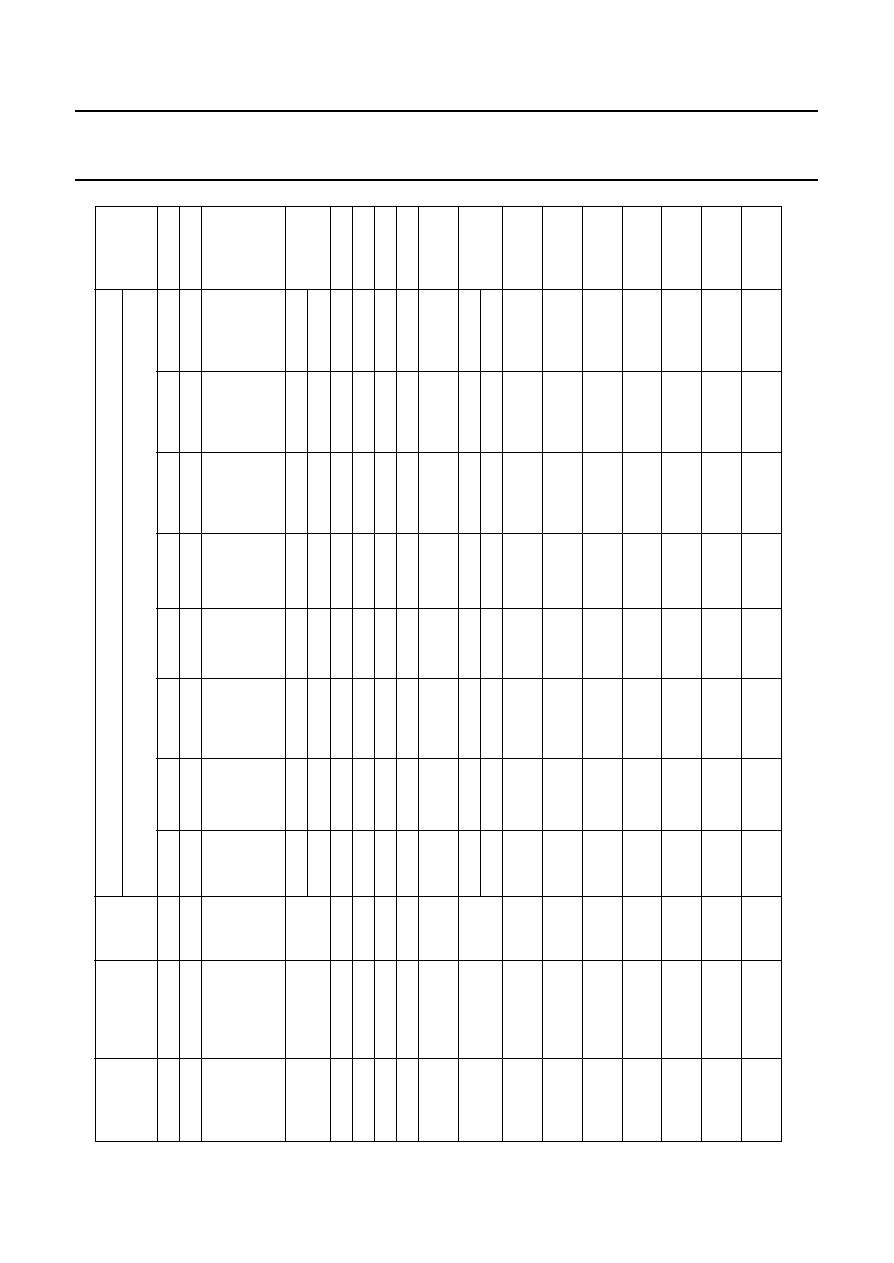
February 1995
16
Philips Semiconductors
Preliminary specification
One page Economy Teletext/TV
microcontroller
SAA5290
T
able 10
SAA5290 Special Function Register map (note
1)
SYMBOL
DESCR.
DIRECT
ADDR.
(HEX)
BIT ADDRESS, SYMBOL OR AL
TERNA
TIVE PORT FUNCTION
RESET
V
ALUE
(HEX)
MSB
LSB
ACC
(2)
Accumulator
E0H
E7
E6
E5
E4
E3
E2
E1
E0
00H
B
(2)
B
register
F0H
F7
F6
F5
F4
F3
F2
F1
F0
00H
DPTR:
Data Pointer
(2
bytes):
DPH
High byte
83H
-
-
-
-
-
---
00H
DPL
Low byte
82H
-
-
-
-
-
---
00H
IE
(2)(3)
Interrupt
Enable
A8H
AF
AE
AD
AC
AB
AA
A9
A8
X
0H
EA
ES1
ET1
EX1
ET0
EX0
P0
(2)
Port
0
80H
87
86
85
84
83
82
81
80
FFH
P1
(2)
Port
1
90H
97
96
95
94
93
92
91
90
FFH
P2
(2)
Port 2
A0H
A7
A6
A5
A4
A3
A2
A1
A0
FFH
P3
(2)(3)
Port
3
B0H
--
-
B4
B3
B2
B1
B0
XXX
11111
B
PCON
(3)
Power
Control
87H
GF1
GF0
XXXX
00
XX
B
PSW
(2)
Program
Status W
ord
D0H
D7
D6
D5
D4
D3
D2
D1
D0
000000
X
0B
CY
AC
F0
RS1
RS0
0V
P
PWM0
(3)
Pulse Width
Modulator
0
D5H
PWE
PV5
PV4
PV3
PV2
PV1
PV0
-
PWM1
(3)
Pulse Width
Modulator
1
D6H
PWE
PV5
PV4
PV3
PV2
PV1
PV0
-
PWM2
(3)
Pulse Width
Modulator
2
D7H
PWE
PV5
PV4
PV3
PV2
PV1
PV0
-
PWM3
(3)
Pulse Width
Modulator
3
DCH
PWE
PV5
PV4
PV3
PV2
PV1
PV0
-
PWM4
(3)
Pulse Width
Modulator
4
DDH
PWE
PV5
PV4
PV3
PV2
PV1
PV0
-
PWM5
(3)
Pulse Width
Modulator
5
DEH
PWE
PV5
PV4
PV3
PV2
PV1
PV0
-
S1BIT
(3)
Serial I
2
C
data
D9H
SDI/
SDO
00H

February 1995
17
Philips Semiconductors
Preliminary specification
One page Economy Teletext/TV
microcontroller
SAA5290
S1INT
(3)
Serial I
2
C
interrupt
DAH
SI
-
S1SCS
(2)(3)
Serial I
2
C
control
D8H
DF
DE
DD
DC
DB
DA
D9
D8
-
SDI/
SDO
SCI/
SDO
CLH
BB
RBF
WBF
STR
ENS
SAD
(2)
(3)
Software
At
oD
E8H
EF
EE
ED
EC
EB
EA
E9
E8
00H
VHI
CH1
CH0
ST
SAD3
SAD2
SAD1
SAD0
SP
Stack Pointer
81H
8F
8E
8D
8C
8B
8A
89
88
07H
TCON
(2)
T
imer/counter
control
88H
TF1
TR1
TF0
TR0
IE1
IT1
IE0
IT0
00H
TDACH
TPWM
High byte
D3H
PWE
TD13
TD12
TD1
1
TD10
TD9
TD8
00H
TDACL
TPWM
Low byte
D2H
TD7
TD6
TD5
TD4
TD3
TD2
TD1
TD0
00H
TH0
T
imer
0
High byte
8CH
-
-
-
-
-
---
00H
TH1
T
imer
1
High byte
8DH
-
-
-
-
-
---
00H
TL0
T
imer
0
Low byte
8AH
-
-
-
-
-
---
00H
TL1
T
imer
1
Low byte
8BH
-
-
-
-
-
---
00H
TMOD
T
imer/counter
mode
89H
GA
TE
C/
TM
1
M
0
G
A
T
E
C
/
T
M
1
M
0
00H
TXT0
(3)
T
eletext
register
0
C0H
X24
POS
AUT
O
FRAME
DISABLE
HDR
ROLL
DISPLA
Y
ST
A
TUS
ROW
ONL
Y
DISABLE
FRAME
00H
TXT1
(3)
T
eletext
register
1
C1H
8-BIT
ACQ OFF
X26
FULL
FIELD
FIELD
POLARITY
H
POLARITY
V
POLARITY
00H
TXT2
(3)
T
eletext
register
2
C2H
SC2
SC1
SC0
00H
TXT3
(3)
T
eletext
register
3
C3H
PRD4
PRD3
PRD2
PRD1
PRD0
00H
SYMBOL
DESCR.
DIRECT
ADDR.
(HEX)
BIT ADDRESS, SYMBOL OR AL
TERNA
TIVE PORT FUNCTION
RESET
V
ALUE
(HEX)
MSB
LSB
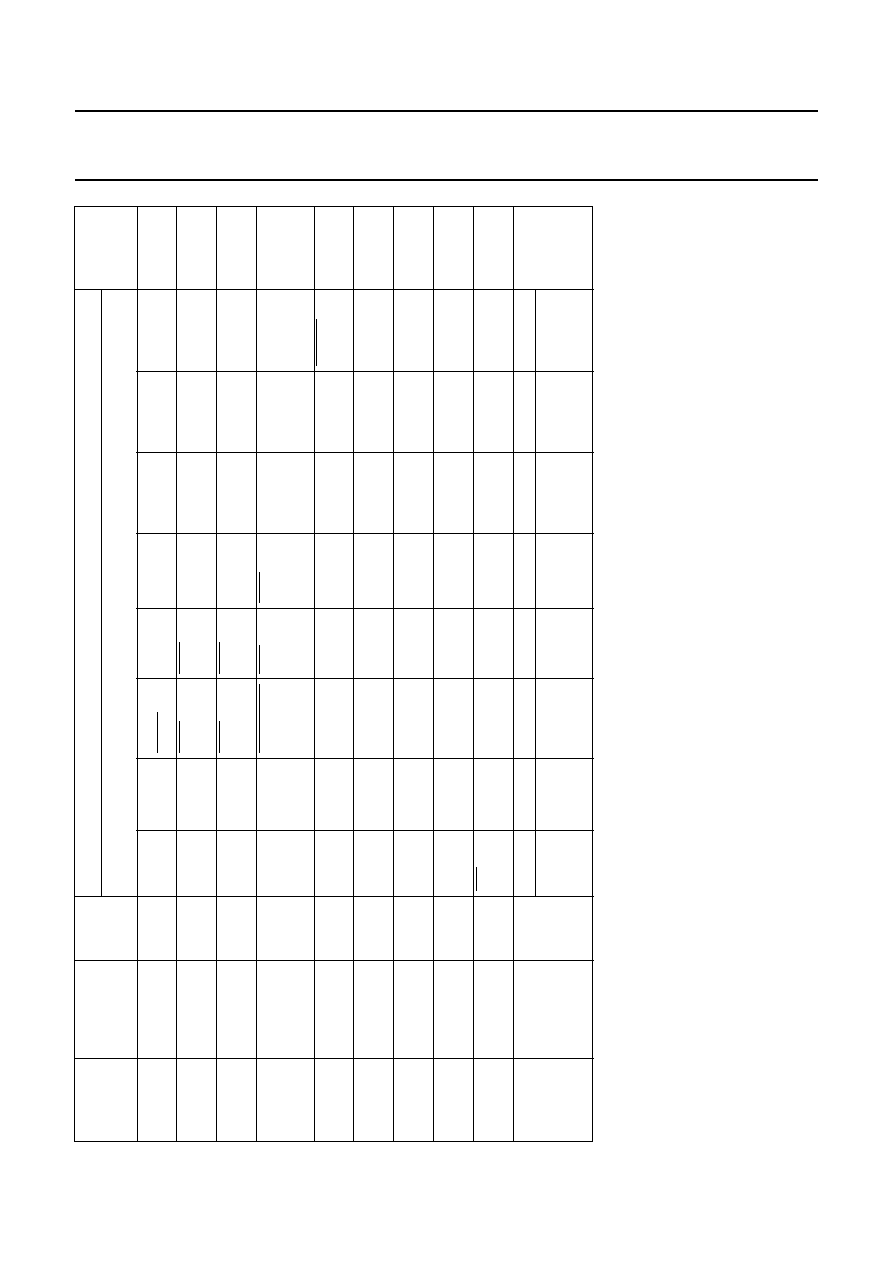
February 1995
18
Philips Semiconductors
Preliminary specification
One page Economy Teletext/TV
microcontroller
SAA5290
Notes
1.
The star (
) indicates these bits are inactive and must be written to logic
0 for future compatibility.
2.
SFRs are bit addressable.
3.
SFRs are modified or added to the 80C51 SFRs.
TXT4
(3)
T
eletext
register
4
C4H
EAST/
WEST
B MESH
ENABLE
C MESH
ENABLE
TRANS
ENABLE
SHADOW
ENABLE
00H
TXT5
(3)
T
eletext
register
5
C5H
BKGND
OUT
BKGND
IN
COR OUT
COR IN
TEXT
OUT
TEXT IN
PICTURE
ON OUT
PICTURE
ON IN
0000001
1B
TXT6
(3)
T
eletext
register
6
C6H
BKGND
OUT
BKGND
IN
COR OUT
COR IN
TEXT
OUT
TEXT IN
PICTURE
ON OUT
PICTURE
ON IN
0000001
1B
TXT7
(3)
T
eletext
register
7
C7H
ST
A
TUS
ROW
TO
P
CURSOR
ON
CONCEAL
/REVEAL
T
OP/
BTM
SNG/DBL
HEIGHT
BOX ON
24
BOX ON
1-23
BOX ON 0
00H
TXT8
(3)
T
eletext
register
8
C8H
CVBS0/
CVBS1
00H
TXT9
(3)
T
eletext
register
9
C9H
CLEAR
MEM.
A0
R4
R3
R2
R1
R0
00H
TXT10
(3)
T
eletext
register
10
CAH
C5
C4
C3
C2
C1
C0
00H
TXT1
1
(3)
T
eletext
register
1
1
CBH
D7
D6
D5
D4
D3
D2
D1
D0
00H
TXT12
(3)
T
eletext
register
12
CCH
625/525
SYNC
ROM
VER R4
ROM
VER R3
ROM
VER R2
ROM
VER R1
ROM
VER R0
TXT ON
VIDEO
QUALITY
TXT13
(2)(3)
T
eletext
register
13
B8H
BF
BE
BD
BC
BB
BA
B9
B8
00H
TXT
I/F
ACE
BUSY
SYMBOL
DESCR.
DIRECT
ADDR.
(HEX)
BIT ADDRESS, SYMBOL OR AL
TERNA
TIVE PORT FUNCTION
RESET
V
ALUE
(HEX)
MSB
LSB

February 1995
19
Philips Semiconductors
Preliminary specification
One page Economy Teletext/TV
microcontroller
SAA5290
Table 11 SFR description
REGISTER
FUNCTION
IE - Interrupt Enable
EA
Disable all interrupts (logic 0) or use individual enable bits (logic 1).
ES1
I
2
C-bus interrupt enable (logic 1).
ET1
Enable Timer 1 overflow interrupt (logic 1).
EX1
Enable external interrupt 1 (logic 1).
ET0
Enable Timer 0 overflow interrupt (logic 1).
EX0
Enable external interrupt 0 (logic 1).
PCON - Power Control
GF0
General purpose flag bit 0.
GF1
General purpose flag bit 1.
PWM0 to PWM5 - 6-bit Pulse Width Modulator control registers
PWE
Activate this 6-bit PWM and take over port pin (logic 1).
PV0 to PV5
Value to output by this 6-bit PWM.
SAD - Software ADC control
VHI
Analog input voltage greater than DAC output voltage (logic 1).
CH0 and CH1
See Table 12.
ST
Initiate voltage comparison (logic 1). This is automatically reset.
SAD0 to SAD3
4-bit DAC input value. The DAC output of this value is compared with analog input voltage.
S1BIT - Serial I
2
C-bus data (READ)
SDI
I
2
C-bus data bit latched-in from SDA on the last rising edge of SCL.
S1BIT - Serial I
2
C-bus data (WRITE)
SDO
I
2
C-bus data bit output.
S1INT - Serial I
2
C-bus interrupt
SI
I
2
C-bus interrupt flag.
S1SCS - Serial I
2
C-bus control (READ)
SDI
Serial data input at SDA.
SCI
Serial clock input at SCL.
CLH
Clock LOW-to-HIGH transition flag.
BB
Bus busy flag.
RBF
Read bit finished flag.
WBF
Write bit finished flag.
STR
Clock stretching enable (logic 1).
ENS
Enable serial I/O (logic 1).

February 1995
20
Philips Semiconductors
Preliminary specification
One page Economy Teletext/TV
microcontroller
SAA5290
S1SCS - Serial I
2
C-bus control (WRITE)
SDO
Serial data output at SDA.
SCO
Serial clock output at SCL.
CLH
Clock LOW-to-HIGH transition.
STR
Clock stretching enable (logic 1).
ENS
Enable serial I/O (logic 1).
TDACH - 14-bit PWM MSB register
PWE
Activate this 14-bit PWM and take over port pin (logic 1).
TD8 to TD13
6 LSBs of this value to be output by the 14-bit PWM.
TDACL - 14-bit PWM LSB register
TD0 to TD7
8 LSBs of this value to be output by the 14-bit PWM.
TXT0 - Teletext register 0 (WRITE only)
X24 POSITION
Store packet 24 in extension packet memory (logic 0) or page memory (logic 1).
AUTO FRAME
Frame output switched off automatically if any video displayed (logic 1).
DISABLE HDR ROLL Do not write rolling headers and time into memory (logic 1).
STATUS ROW ONLY
Display only memory row (logic 1).
DISABLE FRAME
Frame output always LOW (logic 1).
TXT1 - Teletext register 1 (WRITE only)
8-BIT
Data in packets 0 to 24 written into memory without error checking (logic 1).
ACQ OFF
Prevent teletext acquisition section writing to memory (logic 1).
X26
Disable automatic processing of packet 26 data (logic 1).
FULL FIELD
Accept teletext on TV lines 2 to 22 only (logic 0) or on any line (logic 1).
FIELD POLARITY
VSYNC in first half of the line (logic 0) or second half of the line (logic 1) at start of even field.
H POLARITY
HSYNC input positive-going (logic 0) or negative-going (logic 1).
V POLARITY
VSYNC input positive-going (logic 0) or negative-going (logic 1).
TXT2 - Teletext register 2 (WRITE only)
SC0 to SC2
Start column at which page request data written into TXT3 SFR is placed.
TXT3 - Teletext register 3 (WRITE only)
PRD0 to PRD4
Page request data.
TXT4 - Teletext register 4 (WRITE only)
B MESH ENABLE
Enable meshing of area with black background (logic 1).
C MESH ENABLE
Enable meshing of area with other background colours (logic 1).
TRANS ENABLE
Black background colour is transparent i.e. video is displayed (logic 1).
SHADOW ENABLE
Enable south-east shadowing (logic 1).
EAST/WEST
Western European languages displayed (logic 0) or Eastern European languages displayed
(logic 1).
REGISTER
FUNCTION

February 1995
21
Philips Semiconductors
Preliminary specification
One page Economy Teletext/TV
microcontroller
SAA5290
TXT5 - Teletext register 5 (WRITE only)
BKGND OUT
Background colour displayed outside teletext boxes (logic 1).
BKGND IN
Background colour displayed inside teletext boxes (logic 1).
COR OUT
COR output active outside teletext boxes (logic 1).
COR IN
COR output active inside teletext boxes (logic 1).
TEXT OUT
Text displayed outside teletext boxes (logic 1).
TEXT IN
Text displayed inside teletext boxes (logic 1).
PICTURE ON OUT
Video picture displayed outside teletext boxes (logic 1).
PICTURE ON IN
Video picture displayed inside teletext boxes (logic 1).
TXT6 - Teletext register 6 (WRITE only)
-
This register has the same meaning as TXT5 but is only invoked if either newsflash (C5) or the
subtitle (C6) bit in Row 25 of the basic page memory is set.
TXT7 - Teletext register 7 (WRITE only)
STATUS ROW TOP
Display Row 24 below (logic 0) or above (logic 1) teletext page.
CURSOR ON
Display cursor at location pointed to by TXT9 and TXT10 (logic 1).
CONCEAL/REVEAL
Display characters in areas with the conceal attribute set (logic 1).
TOP/BOTTOM
Display Rows 0 to 11 (logic 0) or 12 to 23 (logic 1) when the double height bit is set.
SNG/DBL HEIGHT
Display each character at twice normal height (logic 1).
BOX ON 24
Enable teletext boxes in memory Row 24 (logic 1).
BOX ON 1-23
Enable teletext boxes in memory Rows 1 to 23 (logic 1).
BOX ON 0
Enable teletext boxes in memory Row 0 (logic 1).
TXT8 - Teletext register 8 (WRITE only)
CVBS0/CVBS1
CVBS0 input (logic 0) or CVBS1 (logic 1) inputs used for teletext.
TXT9 - Teletext register 9 (WRITE only)
CLEAR MEMORY
Write 20H into every location in teletext memory (logic 1).
A0
Access basic page memory (logic 0) or extension packet memory (logic 1) with TXT11 SFR.
R0 to R4
Memory row to be accessed with TXT11 SFR.
TXT10 - Teletext register 10 (WRITE only)
C0 to C5
Memory column to be accessed with TXT11 SFR.
TXT11 - Teletext register 11
D0 to D7
data byte written to, or read from, teletext memory.
REGISTER
FUNCTION

February 1995
22
Philips Semiconductors
Preliminary specification
One page Economy Teletext/TV
microcontroller
SAA5290
Table 12 CH1 and CH0 selection
TXT12 - Teletext register 12 (READ only)
625/525 SYNC
A 625 line CVBS signal (logic 0), or a 525 line CVBS signal (logic 1) is being input.
ROM VER R0 to R4
Mask programmable to identify character set version.
TXT ON
Teletext power has been applied to the device (logic 1).
VIDEO QUALITY
CVBS input can be locked on by the teletext decoder (logic 1).
TXT13 - Teletext register 13 (READ only)
TXT I/FACE BUSY
Text interface busy and no access for either READ or WRITE is allowed to SFRs
TXT0 to TXT11 (logic 1). This register bit performs the software handshake to the teletext
control registers.
CH1
CH0
INPUT PIN
0
0
none
0
1
ADC0
1
0
ADC1
1
1
ADC2
REGISTER
FUNCTION
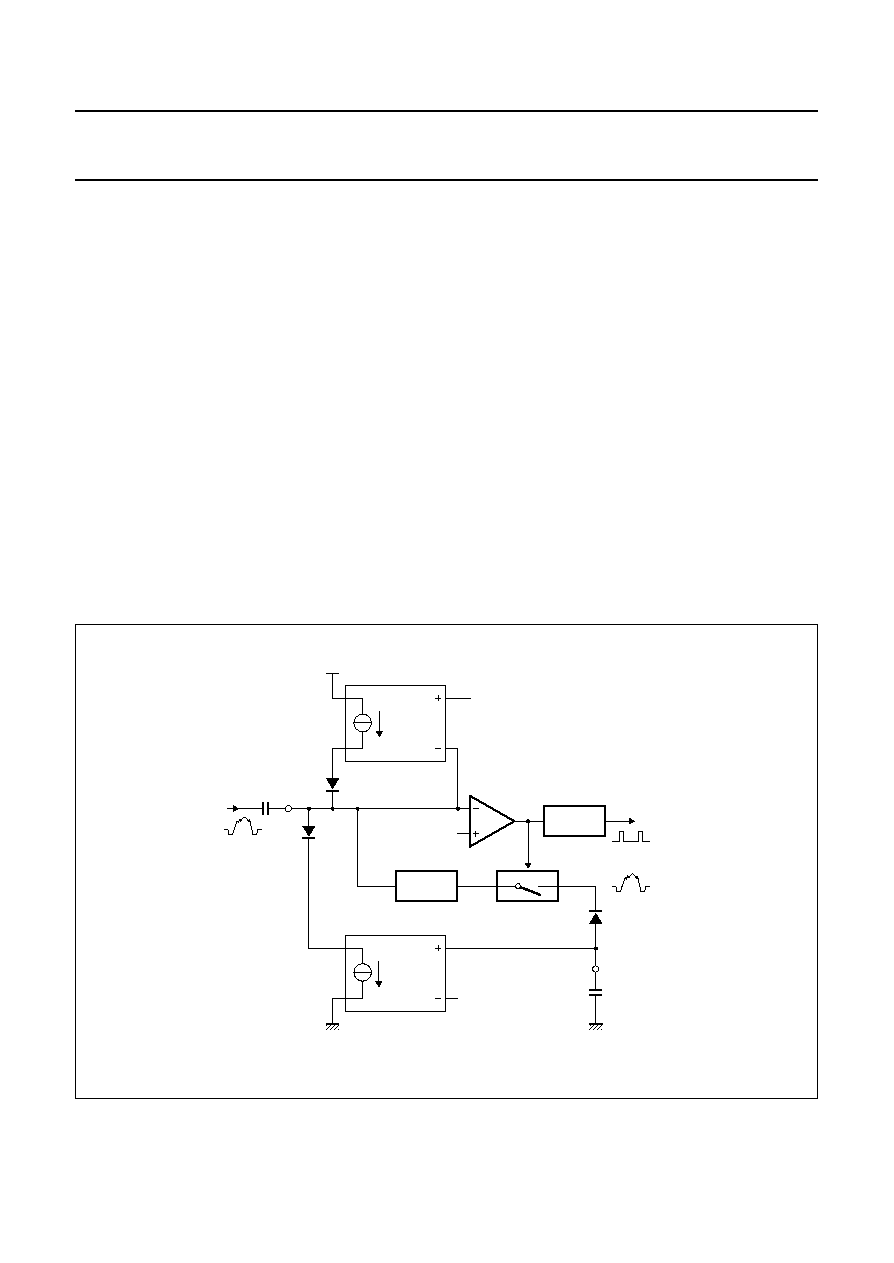
February 1995
23
Philips Semiconductors
Preliminary specification
One page Economy Teletext/TV
microcontroller
SAA5290
TELETEXT DECODER FUNCTIONAL DESCRIPTION
Data slicer
The data slicer extracts the digital teletext data from the
incoming analog waveform. This is performed by sampling
the CVBS waveform and processing the samples to
extract the teletext data and clock.
Acquisition timing
The acquisition timing is generated from a logic level
positive-going composite sync signal `VCS'. This signal is
generated by the sync separator circuit which adaptively
slices the sync pulses at 50% of their height. It is able to do
this over a wide range of sync amplitudes by using the
same basic principle used on VIP1 (SAA5230) and VIP2
(SAA5231).
Figure 4 is a block diagram showing the principles of
operation. It relies upon the fact that the ratio of the sync
width to the line time is approximately 13 : 1. In order to
slice the sync pulse at the correct 50% level two currents
are generated.
One is constant and is proportional to the difference
between the black level of the video and the slicing level.
The other is produced only when the video is below the
slicing level, and is also proportional to the difference
between the slicing level and the input, but has a
magnitude13 times greater.
The black level is determined by a sync-gated peak
detector. The video is negatively peak detected into an
external capacitor (BLACK, pin 25), but not during the
sync pulse VCS. The two currents are integrated on the
CVBS input coupling capacitor and the net effect is to alter
the mean input voltage until the (fixed) slicing level is
correct.
The acquisition clocking and timing are locked to the VCS
signal using a digital phased-locked-loop. The phase error
in the acquisition phase-locked-loop is detected by a
signal quality circuit which disables acquisition if poor
signal quality is detected.
Fig.4 Sync separator block diagram.
handbook, full pagewidth
MLC105
VDD
Vref
Vref
Vref
CVBS
(= slicing level)
FILTER
FILTER
gated negative peak detector
BLACK
VCS
1/3V (mA)
i
1/39V (mA)
i

February 1995
24
Philips Semiconductors
Preliminary specification
One page Economy Teletext/TV
microcontroller
SAA5290
Teletext acquisition
The SAA5290 is able to acquire 625-line World System
Teletext. Teletext is acquired under control of the on-board
80C51 microcontroller. Pages are requested by writing a
series of bytes into the TXT3 SFR which corresponds to
the number of the page required. The bytes written into
TXT3 are put into a small RAM with an auto-incrementing
address. The start address for the RAM is set using the
SFR TXT2 register. Table 13 shows the contents of the
page request RAM.
If the `DO CARE' bit for part of the page number is set to
logic 0 then that part of the page number is ignored when
the acquisition section is deciding whether a page being
received off air should be stored or not. For example if the
`DO CARE' bits for the 4 subcode digits are all set to
logic 0 then every subcode version of the page will be
captured.
When the `HOLD' bit is set to logic 0 the acquisition section
will not recognize any page as having the correct page
number and no pages will be captured.
Table 13 Register map for page requests (TXT3); note 1
Note
1. X = don't care.
START
COLUMN
PRD4
PRD3
PRD2
PRD1
PRD0
0
DO CARE
Magazine
HOLD
MAG2
MAG1
MAG0
1
DO CARE
Page tens
PT3
PT2
PT1
PT0
2
DO CARE
Page units
PU3
PU2
PU1
PU0
3
DO CARE
Hours tens
X
X
HT1
HT0
4
DO CARE
Hours units
HU3
HU2
HU1
HU0
5
DO CARE
Minutes tens
X
MT2
MT1
MT0
6
DO CARE
Minutes units
MU3
MU2
MU1
MU0
Page memory organization
The acquired teletext packets each contain 40 bytes of
data and one packet is stored in each row of the text
memory. The page memory organization is given in Fig.5.
Rows 0 to 23 form the teletext page; Row 24 is available
for status messages and FLOF/FASTEXT prompt
information.

February 1995
25
Philips Semiconductors
Preliminary specification
One page Economy Teletext/TV
microcontroller
SAA5290
Fig.5 Basic page memory organization.
handbook, full pagewidth
MLC106
7 characters
for status
8 characters
usually rolling
(time)
fixed character written by
hardware, alphanumerics white nor-
mally, alphanumerics green when
looking for display page
6
1
7 8
39
31 32
24 characters from page header
rolling when display page looked for
5
to
20
0
1
2
3
4
ROW
21
22
23
24
25
MAIN PAGE DISPLAY AREA
PACKET X / 22
PACKET X / 23
PACKET X24 STORED HERE IF TXT0.7 = 1
10
14
10 bytes for
received
page information
14 bytes
free for use
by microcontroller
R
OW
0 (see Fig.5)
Row 0 is for the page header. The first seven characters
(0 to 6) are free for status messages. Character 8 is an
alphanumeric white or green control character, written
automatically by SAA5290 to give a green rolling header
when a page is being looked for. The last eight characters
are for rolling time.
R
OW
25 (see Fig.5)
The first 10 bytes of row 25 contain control data relating to
the received page as shown in Table 14. The remaining 14
bytes are free for use by the microcontroller.
Extension packet memory organization
If TXT0.X24 POS bit is set to logic 0, then Packet 24 is
written into Row 0 of the extension memory.
Packet X27/0 is written to Row 1 of the extension memory,
with bytes 0 to 37 being Hamming checked automatically.
Packet 8/30 is written to Row 2 of the extension memory,
with bytes 0 to 6 being 8/4 Hamming checked, bytes
7 to 19 unchecked and bytes 20 to 39 odd parity checked.
Packet 26 processing
The SAA5290 contains on-board hardware processing of
Packet 26 data. If a character corresponding to that being
transmitted is available in the character set then the
correct character code is written into the display memory.
Fig.6 Organization of the extension memory.
handbook, halfpage
MLC107
PACKET X24 if TXT0.X24 POS = 0
PACKET X27 / 0
PACKETS 8 / 30 / 0 to 15
1
0
2
ROW

February 1995
26
Philips Semiconductors
Preliminary specification
One page Economy Teletext/TV
microcontroller
SAA5290
Table 14 Row 25 received control data format
Table 15 Page number and sub-code for Table 14
ROW 25
D0
PU0
PT0
MU0
MT0
HU0
HT0
C7
C11
MAG0
0
D1
PU1
PT1
MU1
MT1
HU1
HT1
C8
C12
MAG1
0
D2
PU2
PT2
MU2
MT2
HU2
C5
C9
C13
MAG2
0
D3
PU3
PT3
MU3
C4
HU3
C6
C10
C14
0
0
D4
HAM.ER HAM.ER HAM.ER HAM.ER HAM.ER HAM.ER HAM.ER HAM.ER FOUND
0
D5
0
0
0
0
0
0
0
0
0
PBLF
D6
0
0
0
0
0
0
0
0
0
0
D7
0
0
0
0
0
0
0
0
0
0
Column
0
1
2
3
4
5
6
7
8
9
BIT NAME
DESCRIPTION
Page number
MAG
magazine
PU
page units
PT
page tens
PBLF
page being looked for
HAM.ER
Hamming error in corresponding byte
Page sub-code
MU
minutes units
MT
minutes tens
HU
hours units
HT
hours tens
C4 to C14
transmitted control bits

February 1995
27
Philips Semiconductors
Preliminary specification
One page Economy Teletext/TV
microcontroller
SAA5290
Display
The capabilities of the display are based on the
requirements of level 1 teletext, with some enhancements
for use with locally generated On-Screen Displays (OSD).
The display consists of 25 rows each of 40 characters,
with the characters displayed being those from
Rows 0 to 24 of the basic page memory. The page
memory stores 8-bit character codes which correspond to
260 displayable characters and 44 control codes, normally
displayed as spaces. Each character is defined by a matrix
12 pixels high and 10 pixels deep. When displayed each
pixel is 0.5
µ
s wide and 1 TV line, in each field, high.
The SAA5290 signals the TV display circuits to display the
RGB outputs of the SAA5290 rather than video picture by
setting VDS HIGH. The way in which this signal is switched
is controlled by the TXT5 and TXT6 SFRs. There are three
control functions: background on, text on and picture on.
There are separate bits for each function for inside and
outside teletext boxes and if the newsflash or subtitle bits
are set. This allows the software to configure the type of
display required. The effect of the combination of these
bits is given in Table 16. The COR bits in Register 5 and
Register 6 control when the output is pulled LOW. This
output is intended to act on the TV display circuits to
reduce the contrast of the video display.
The display character set is given in Fig.9. The character
set provided contains all the characters required to display
Eastern and Western European languages. Register bit
TXT4.EAST/ WEST sets whether Eastern or Western
languages are set with the C12 to C14 bits. In order to
make on-screen displays easy to use, the SAA5290
contains additional display attributes in Column 11.
Control codes are categorized as `set at' or `set after'.
`Set at' means the code has effect at the current character
position and `set after' means they have effect from the
following character. Codes 11/0 to 11/7 are always
`set at'. Codes 11/11 to 11/15 are `set after' when defining
the start of an OSD box and `set at' when ending an OSD
box. Codes 11/12 to 11/15 force a box condition allowing
on-screen display messages to be displayed without
having to erase the whole contents of the teletext page.
On-screen displays are only available in TV mode and not
in text mode. In mixed text and TV mode the displayed
screen is not defined if an OSD box is encountered in the
page memory.
Table 16 Display mode
PICTURE ON
TEXT ON
BACKGROUND ON
RESULT
0
0
X
text mode, black screen
0
1
0
text mode, background always black
0
1
1
text mode
1
0
X
TV mode
1
1
0
mixed mode and TV mode
1
1
1
text mode, TV picture outside text area
Display timing
The display circuitry is driven from the H/VSYNC inputs,
and is independent of the input video signal. Consequently
HSYNC and VSYNC are always required to slave
synchronize the display.
The FRAME output of the SAA5290 is provided to facilitate
de-interlacing the teletext display. The behaviour of
FRAME is controlled via the register bits
TXT0.DISABLE FRAME, TXT0.AUTO FRAME and
TXT1.FIELD POLARITY. If the active edge of VSYNC
occurs in the first half of a TV line then the field is even, and
if the active edge of VSYNC is in the second half of a line
then the field is odd. The active edge is controlled with
TXT1.V POLARITY. With TXT0.AUTO FRAME LOW
FRAME is HIGH for an odd field and LOW for an even
field. With TXT0.AUTO FRAME HIGH FRAME is only
active when text is being displayed, when video is
displayed it is forced LOW. When TXT0.DISABLE FRAME
is HIGH FRAME is always LOW. If
TXT1.FIELD POLARITY is logic 1 then VSYNC is delayed
by 32
µ
s before being applied to the display timing circuits.

February 1995
28
Philips Semiconductors
Preliminary specification
One page Economy Teletext/TV
microcontroller
SAA5290
Clock generator
The oscillator circuit of the SAA5290 is a single-stage
inverting amplifier in a Pierce oscillator configuration. The
circuitry between OSCIN and OSCOUT is basically an
inverter biased to the transfer point. A crystal must be
used as the feedback element to complete the oscillator
circuitry. It is operated in parallel resonance. OSCIN is the
high gain amplifier input and OSCOUT is the output. To
drive the SAA5290 externally OSCIN is driven from an
external source and OSCOUT is left open-circuit.
Fig.7 Oscillator circuit.
(1) The values of C1 and C2 depend on the crystal specification:
C1 = C2 = 2C
L
.
handbook, halfpage
MLC110
OSCOUT
OSCIN
OSCGND
C1
(1)
C2
(1)
Fig.8 Oscillator circuit driven from external source.
handbook, halfpage
MLC111
OSCOUT
OSCIN
OSCGND
not connected
external clock
not connected
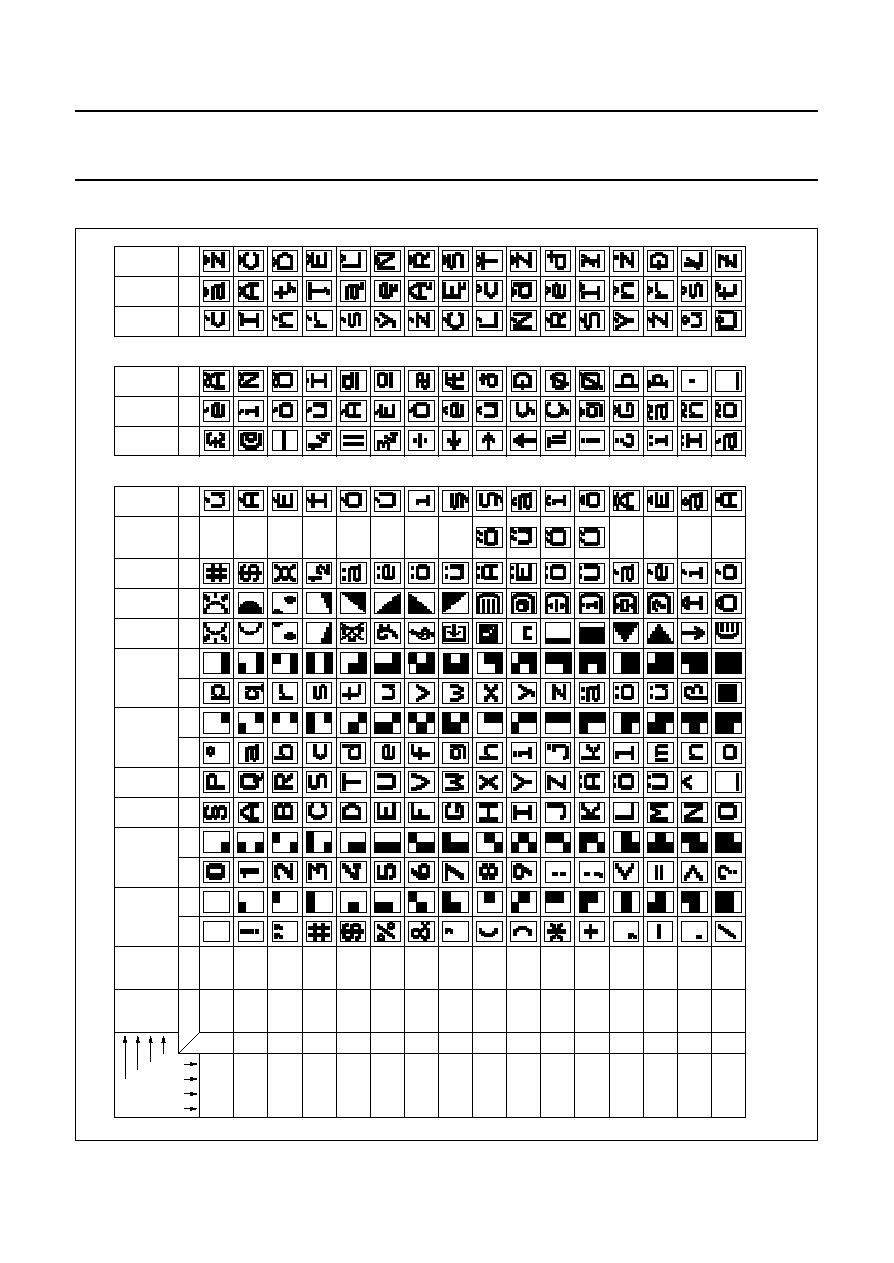
February 1995
29
Philips Semiconductors
Preliminary specification
One page Economy Teletext/TV
microcontroller
SAA5290
CHARACTER SETS
handbook, full pagewidth
MLC108
normal
height
b
3
b
2
b
1
b
0
b
4
b
5
b
6
b
7
0
1
22
a3
3
a
4
5
6
6
a
77
a
8
9
C
column
r
o
w
B
I
T
S
0
0
0
0
0
0
0
1
0
1
0
0
0
1
0
1
1
0
0
0
1
0
0
1
A
1
0
1
0
1
1
0
0
0
1
1
0
0
0
1
1
0
0
1
0
0
1
1
1
E
1 1 1 0
double
width
hold
graphics
F
1 1 1 1
double
size
release
graphics
B
1 0 1 1
start box
C
1 1 0 0
black
back -
ground
D
1 1 0 1
double
height
new
back -
ground
A
1 0 1 0
end box
separated
graphics
9
1 0 0 1
steady
contiguous
graphics
8
1 0 0 0
flash
conceal
display
7
0 1 1 1
alpha -
numerics
white
graphics
white
6
0 1 1 0
alpha -
numerics
cyan
graphics
cyan
5
0 1 0 1
alpha -
numerics
magenta
graphics
magenta
4
0 1 0 0
alpha -
numerics
blue
graphics
blue
3
0 0 1 1
alpha -
numerics
yellow
graphics
yellow
2
0 0 1 0
alpha -
numerics
green
graphics
green
0
0 0 0 0
alpha -
numerics
black
graphics
black
1
0 0 0 1
alpha -
numerics
red
graphics
red
B
1
0
1
1
DE
F
1
1
0
1
1
1
1
0
1
1
1
1
DE
F
1
1
0
1
1
1
1
0
1
1
1
1
double
width
OSD
double
size
OSD
normal
size
OSD
double
height
OSD
back-
ground
white
back-
ground
cyan
back-
ground
magenta
back-
ground
blue
back-
ground
yellow
back-
ground
green
back-
ground
black
back
ground
red
Fig.9 SAA5290 European character set.

February 1995
30
Philips Semiconductors
Preliminary specification
One page Economy Teletext/TV
microcontroller
SAA5290
Fig.10 SAA5290 European national option characters.
handbook, full pagewidth
MLC109
LANGUAGE
C12 C13 C14
PHCB
0
0
0
0
0
1
0
1
0
0
1
1
1
0
0
FRENCH
ITALIAN
SWEDISH
GERMAN
ENGLISH
2 / 3
2 / 4
4 / 0
5 / B
5 / C
5 / D
5 / E
5 / F
6 / 0
7 / B
7 / C
7 / D
7 / E
CHARACTER POSITION (COLUMN / ROW)
SPANISH
1
0
E/W
0
1
1
1
ENGLISH
0
0
0
0
1
GERMAN
1
0
1
0
ESTONIAN
1
0
1
1
GERMAN
1
1
0
0
GERMAN
1
0
0
0
0
1
1
1
0
0
TURKISH
0
0
1
0
1
0
1
1
1
0
1
1
1
1
1
1
RUMANIAN
CZECHOSLOVAKIA
SERBO-CROAT
POLISH
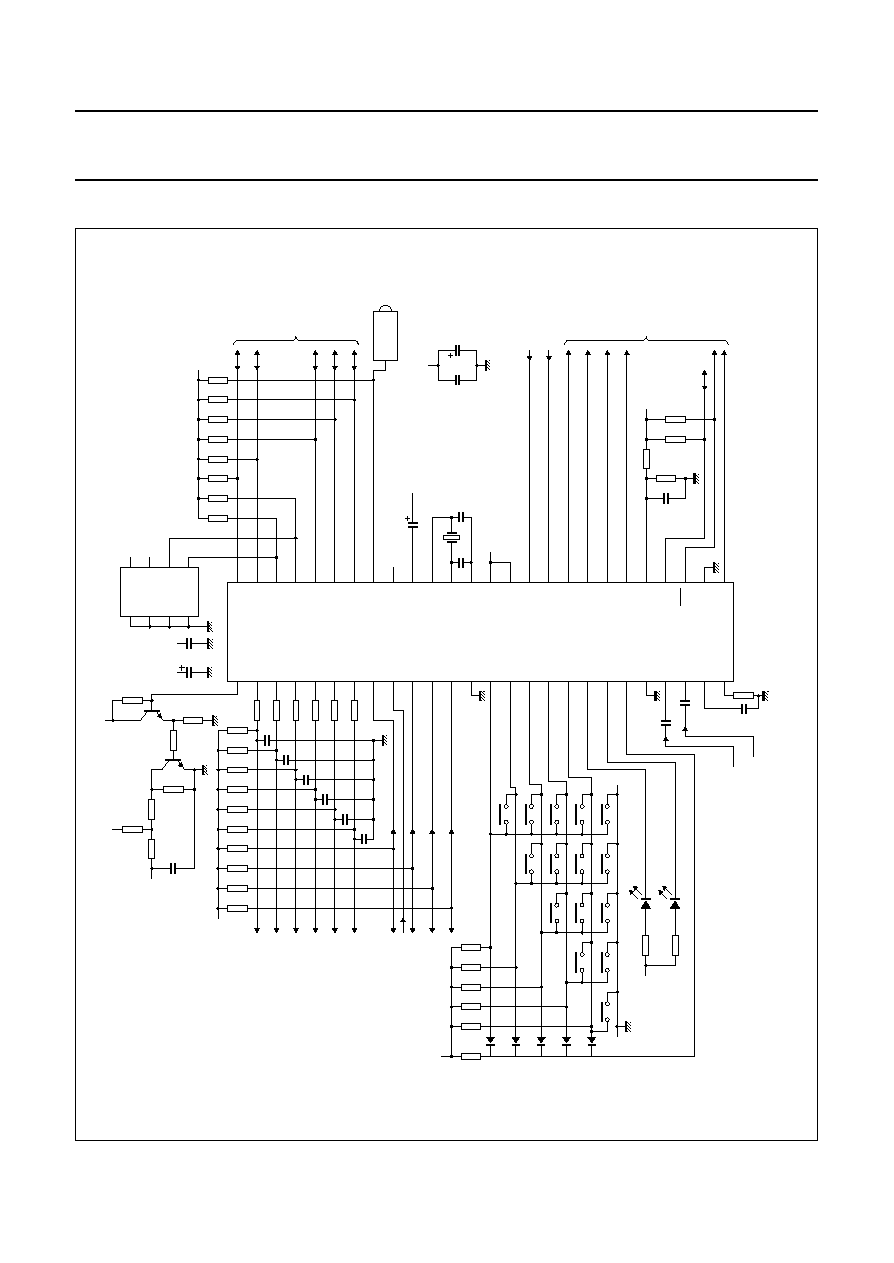
February 1995
31
Philips Semiconductors
Preliminary specification
One page Economy Teletext/TV
microcontroller
SAA5290
APPLICATION INFORMATION
handbook, full pagewidth
MLC112
V
DD
40 V
V
tune
P2.0/TPWM
P2.1/PWM0
P2.2/PWM1
P2.3/PWM2
P2.4/PWM3
P2.5/PWM4
P2.6/PWM5
P2.7
P3.0/ADC0
P3.1/ADC1
P3.2/ADC2
P3.3
V
SSD
P0.0
P0.1
P0.2
P0.3
P0.4
P0.5
P0.6
P0.7
V
SSA
CVBS0
CVBS1
BLACK
IREF
brightness
contrast
saturation
hue
volume (L)
volume (R)
V
afc
V
DD
27 k
100
nF
CVBS (SCART)
CVBS (IF)
100 nF
100 nF
V
DD
V
DD
P1.5
P1.4
P1.7/SDA
P1.6/SCL
P1.3/T1
P1.2/INT0
P1.1/T0
P1.0/INT1
RESET
OSCOUT
OSCIN
VSYNC
HSYNC
VDS
R
G
B
P3.4
COR
RGBREF
FRAME
V
DDM
OSCGND
V
DDT
V
DDA
V
SSD2
SDA
SCL
RC
A0
SAA5290
EEPROM
PCF8582E
A1
A2
V
DD
V
SS
V
DD
V
DD
V
DD
100
nF
47
µ
F
V
DD
4.7
k
TV
control
signals
IR
RECEIVER
V
DD
V
DD
2.2
µ
F
12 MHz
V
DD
V
DD
100
nF
47
µ
F
field flyback
line flyback
to TV's
display
circuits
V
DD
1
k
10
k
3.3
k
100 nF
PH2369
1 k
Fig.11 Typical application diagram.

February 1995
32
Philips Semiconductors
Preliminary specification
One page Economy Teletext/TV
microcontroller
SAA5290
PACKAGE OUTLINE
Fig.12 Plastic shrink dual in-line package; 52
leads (600
mil) SDIP52, SOT247-1.
Dimensions in mm.
handbook, full pagewidth
1
27
26
1.3 max
14.1
13.7
47.92
47.02
4.57
max
5.08
max
0.51
min
3.2
2.8
seating plane
0.18
M
0.53
max
1.778
(25x)
1.73
max
15.80
15.24
0.32 max
15.24
17.15
15.90
MSA267
52

February 1995
33
Philips Semiconductors
Preliminary specification
One page Economy Teletext/TV
microcontroller
SAA5290
SOLDERING
Plastic dual in-line packages
B
Y DIP OR WAVE
The maximum permissible temperature of the solder is
260
∞
C; this temperature must not be in contact with the
joint for more than 5 s. The total contact time of successive
solder waves must not exceed 5 s.
The device may be mounted up to the seating plane, but
the temperature of the plastic body must not exceed the
specified storage maximum. If the printed-circuit board has
been pre-heated, forced cooling may be necessary
immediately after soldering to keep the temperature within
the permissible limit.
R
EPAIRING SOLDERED JOINTS
Apply the soldering iron below the seating plane (or not
more than 2 mm above it). If its temperature is below
300
∞
C, it must not be in contact for more than 10 s; if
between 300 and 400
∞
C, for not more than 5 s.
DEFINITIONS
LIFE SUPPORT APPLICATIONS
These products are not designed for use in life support appliances, devices, or systems where malfunction of these
products can reasonably be expected to result in personal injury. Philips customers using or selling these products for
use in such applications do so at their own risk and agree to fully indemnify Philips for any damages resulting from such
improper use or sale.
Data sheet status
Objective specification
This data sheet contains target or goal specifications for product development.
Preliminary specification
This data sheet contains preliminary data; supplementary data may be published later.
Product specification
This data sheet contains final product specifications.
Limiting values
Limiting values given are in accordance with the Absolute Maximum Rating System (IEC 134). Stress above one or
more of the limiting values may cause permanent damage to the device. These are stress ratings only and operation
of the device at these or at any other conditions above those given in the Characteristics sections of the specification
is not implied. Exposure to limiting values for extended periods may affect device reliability.
Application information
Where application information is given, it is advisory and does not form part of the specification.
PURCHASE OF PHILIPS I
2
C COMPONENTS
Purchase of Philips I
2
C components conveys a license under the Philips' I
2
C patent to use the
components in the I
2
C system provided the system conforms to the I
2
C specification defined by
Philips. This specification can be ordered using the code 9398 393 40011.
































